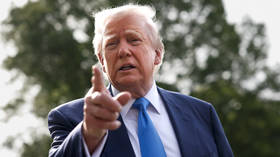No ‘soft landing’ likely for US economy – Fed chairman

Federal Reserve Chairman Jerome Powell said on Monday that the central bank will raise interest rates “more aggressively” in order to get spiraling prices under control. However, he acknowledged that doing this without crashing the economy would prove “challenging,” and cautioned that a “soft landing” is not guaranteed.
Powell made his comments in a speech to the National Association for Business Economics, which was reported by multiple US news outlets.
“We will take the necessary steps to ensure a return to price stability,” he said. “In particular, if we conclude that it is appropriate to move more aggressively by raising the federal funds rate by more than 25 basis points at a meeting or meetings, we will do so.”
A single basis point is equal to 0.01 percent. Last week the Federal Reserve increased its rates by 25 points, or 0.25%, raising the cost of borrowing from where it had sat near zero for the last three years to 0.5%. Fed officials predicted another six such increases over the remainder of 2022 and at least three in 2023.
The Federal Reserve controls the short-term borrowing rate for commercial banks, which then pass this rate on to their customers. Higher rates make borrowing money less viable, which contracts the economy and lowers inflation. This method of reining in inflation was practiced most dramatically in the 1970s, when the Fed hiked interest rates to over 20% and stopped all bond purchases.
Under both the Trump and Biden administrations, interest rates have been kept at rock bottom, while both presidents flooded the economy with money: Trump by overseeing the creation of a quarter of all the dollars ever created in 2020 and Biden by spending more in the first eight months of his presidency than Trump did in 2018 and 2019 combined, according to Fox News.
Powell cautioned that readjusting the American economy downwards will not be a simple task. “No one expects that bringing about a soft landing will be straightforward in the current context,” he said on Monday, adding: “Very little is straightforward in the current context.”
Monetary policy – the discipline of economic management that interest manipulation falls under – is a “blunt instrument, not capable of surgical precision,” he continued, adding that “My colleagues and I will do our very best to succeed in this challenging task.”
Core inflation – a metric often cited by the Fed which excludes food and energy costs – rose 5.2% in January, the sharpest increase in 38 years when compared with the preceding January. Separate metrics by the US Department of Commerce showed the cost of goods and services up 7% in the fourth quarter of 2021, with food prices up 9% and energy costs up 34%. Far sharper increases in the cost of certain items, such as meat, have been reported by American shoppers, too.
Once described by the Biden administration as “transitory,” inflation has been compounded by coronavirus-related supply chain disruptions, and shocks to global energy, grain, and fertilizer markets following the outbreak of war in Ukraine.














